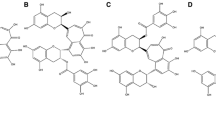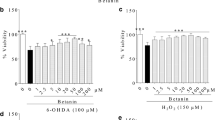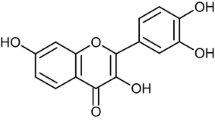Abstract
Neuroprotection using compounds with dual functions of anti-apoptotic and antioxidant effects fight against neurodegeneration. Vitamin K2 acts as a cofactor in many biochemical pathways, including sphingolipid synthesis in the nervous system, which is involved in many cellular events, including proliferation, differentiation, cellular communication, and alteration. This study aimed to investigate the protective effects of vitamin K2 in PC12 cells as an in vitro model of Parkinson’s disease. The protective effects of vitamin K2 against 6-OHDA-induced apoptosis in PC12 cells were assessed using resazurin for viability, DCF-DA for ROS level, DTNB for glutathione level, flow cytometry for sub G1, and western blot analysis for detecting bax and pro-caspase-3 expression level. The results showed that 6-OHDA significantly decreased cell viability, glutathione and pro-caspase-3 levels, and increased ROS, the amount of bax in PC12 cells, while the pretreatment with 5 μM vitamin K2 significantly decreased the cell death induced by 6-OHDA. Generally, the results may present a new insight about the potential protective action of vitamin K2 against the progression of Parkinson’s disease. Further studies may warrant the use of vitamin K2 as an antioxidant and anti-apoptotic agent in slowing nerve injury in neurodegenerative disease, particularly in Parkinson’s disease.




Similar content being viewed by others
Abbreviations
- Vit K2:
-
Vitamin K2
- ROS:
-
Reactive oxygen species
- GSH:
-
Glutathione
- 6-OHDA:
-
6-Hydroxydopamine
- PD:
-
Parkinson’s disease
- NGF:
-
Nerve growth factor
- DCFH-DA:
-
2′, 7′-Dichlorofluorescin diacetate
- DTNB:
-
5-5′-Dithiobis (2-nitrobenzoic acid)
- PI:
-
Propidium iodide
- NFκB:
-
Nuclear factor κB
- ANOVA:
-
One-way analysis of variance
- iNOS:
-
Inducible nitric oxide synthase
- RNS:
-
Reactive nitrogen species
References
Plaza SM, Lamson DW (2005) Vitamin K2 in bone metabolism and osteoporosis. Altern Med Rev 10:24–35
Ferland G (2012) Vitamin K and the nervous system: an overview of its actions. Adv Nutr 3:204–212
Beulens JW, Booth SL, van den Heuvel EG, Stoecklin E, Baka A, Vermeer C (2013) The role of menaquinones (vitamin K 2) in human health. Br J Nutr 110:1357–1368
Ferland G (2012) Vitamin K, an emerging nutrient in brain function. BioFactors 38:151–157
Iwamoto J, Sato Y, Takeda T, Matsumoto H (2012) Strategy for prevention of hip fractures in patients with Parkinson’s disease. World J Orthop 3:137–141
Jankovic J (2008) Parkinson’s disease: clinical features and diagnosis. J Neurol Neurosurg Psychiatry 79:368–376
Winklhofer KF, Haass C (2010) Mitochondrial dysfunction in Parkinson’s disease. Biochim Biophys Acta 1802:29–44
Mousavi SH, Motaez M, Zamiri-Akhlaghi A, Emami SA, Tayarani-Najaran Z (2014) In-Vitro evaluation of cytotoxic and apoptogenic properties of Sophora Pachycarpa. Iran J Pharm Res 13:665–673
O’brien J, Wilson I, Orton T, Pognan F (2000) Investigation of the Alamar Blue (resazurin) fluorescent dye for the assessment of mammalian cell cytotoxicity. Eur J Biochem 267:5421–5426
Tayarani-Najaran Z, Sareban M, Gholami A, Emami SA, Mojarrab M (2013) Cytotoxic and apoptotic effects of different extracts of Artemisia turanica Krasch on K562 and HL-60 cell lines. Sci World 2013:628073–628079
Chen X, Zhong Z, Xu Z, Chen L, Wang Y (2010) 2′, 7′-Dichlorodihydrofluorescein as a fluorescent probe for reactive oxygen species measurement: forty years of application and controversy. Free Radic Res 44:587–604
Lin CM, Lin RD, Chen ST, Lin YP, Chiu WT, Lin JW, Hsu FL, Lee MH (2010) Neurocytoprotective effects of the bioactive constituents of Pueraria thomsonii in 6-hydroxydopamine (6-OHDA)- treated nerve growth factor (NGF)-differentiated PC12 cells. Phytochemistry 71:2147–2156
Paglia DE, Valentine WN (1967) Studies on the quantitative and qualitative characterization of erythrocyte glutathione peroxidase. J Lab Clin Med 70:158–169
Riccardi C, Nicoletti I (2006) Analysis of apoptosis by propidium iodide staining and flow cytometry. Nat Protoc 1:1458
Ramazani E, Tayarani-Najaran Z, Fereidoni M (2019) Celecoxib, indomethacin and ibuprofen prevent 6-hydroxydopamine-induced PC12 cell death through the inhibition of NFκB and SAPK/JNK pathways. Iran J Basic Med Sci 22:477–484
Thijssen HH, Drittij-Reijnders MJ (1994) Vitamin K distribution in rat tissues: dietary phylloquinone is a source of tissue menaquinone-4. Br J Nutr 72:415–425
Sundaram KS, Fan JH, Engelke JA, Foley AL, Suttie JW, Lev M (1996) Vitamin K status influences brain sulfatide metabolism in young mice and rats. J Nutr 126:2746–2751
Crivello NA, Casseus SL, Peterson JW, Smith DE, Booth SL (2010) Age-and brain region-specific effects of dietary vitamin K on myelin sulfatides. J Nutr Biochem 21:1083–1088
Blum D, Torch S, Lambeng N, Nissou MF, Benabid AL, Sadoul R, Verna JM (2001) Molecular pathways involved in the neurotoxicity of 6-OHDA, dopamine and MPTP: contribution to the apoptotic theory in Parkinson’s disease. Prog Neurobiol 65:135–172
Sada E, Abe Y, Ohba R, Tachikawa Y, Nagasawa E, Shiratsuchi M, Takayanagi R (2010) Vitamin K2 modulates differentiation and apoptosis of both myeloid and erythroid lineages. Eur J Haematol 85:538–548
Huang Y, Hu Z (2018) UBIAD1 protects against oxygen-glucose deprivation/reperfusion-induced multiple subcellular organelles injury through PI3K/AKT pathway in N2A cells. J Cell Physiol 233:7480–7496
Furie B, Bouchard BA, Furie BC (1999) Vitamin K-dependent biosynthesis of γ-carboxyglutamic acid. Blood 93:1798–1808
Hara K, Akiyama Y, Tajima T, Shiraki M (1993) Menatetrenone inhibits bone resorption partly through inhibition of PGE2 synthesis in vitro. J Bone Miner Res 8:535–542
Gehrmann J, Gold R, Linington C, Lannes-Vieira J, Wekerle H, Kreutzberg GW (1993) Microglial involvement in experimental autoimmune inflammation of the central and peripheral nervous system. Glia 7:50–59
Yu YX, Li YP, Gao F, Hu QS, Zhang Y, Chen D, Wang GH (2016) Vitamin K 2 suppresses rotenone-induced microglial activation in vitro. Acta Pharmacol Sin 37:1178–1189
Li J, Lin JC, Wang H, Peterson JW, Furie BC, Furie B, Booth SL, Volpe JJ, Rosenberg PA (2003) Novel role of vitamin k in preventing oxidative injury to developing oligodendrocytes and neurons. J Neurosci 23:5816–5826
Acknowledgements
This work was supported by Grant No. 3/42877 from the Ferdowsi university of Mashhad, Mashhad, Iran and Grant No. 951667 from the Research Affairs of Mashhad University of Medical Sciences. The authors wish to thank Mr. Malaeke for reading the flow cytometry samples.
Funding
This work has been supported by Grant No. 3/42877 from the Ferdowsi University of Mashhad, Mashhad, Iran and Grant No. 951667 from the Research Affairs of Mashhad University of Medical Sciences, Mashhad, Iran.
Author information
Authors and Affiliations
Contributions
ER performed the experiments and wrote the manuscript. MF and ZTN conceived, designed, and supervised the project, wrote the manuscript and provided financial support.
Corresponding author
Ethics declarations
Conflict of interest
There is no conflict of interest in this study.
Ethical approval
As this work is carried out in PC12 cells, there is no need for ethical clearance.
Research involving human and animal rights
Human/animals subjects were not used in the study.
Additional information
Publisher's Note
Springer Nature remains neutral with regard to jurisdictional claims in published maps and institutional affiliations.
Rights and permissions
About this article
Cite this article
Ramazani, E., Fereidoni, M. & Tayarani-Najaran, Z. Protective effects of vitamin K2 on 6-OHDA-induced apoptosis in PC12 cells through modulation bax and caspase-3 activation. Mol Biol Rep 46, 5777–5783 (2019). https://doi.org/10.1007/s11033-019-05011-2
Received:
Accepted:
Published:
Issue Date:
DOI: https://doi.org/10.1007/s11033-019-05011-2




